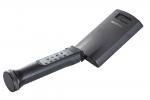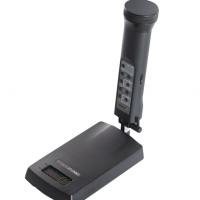Ultra-Compact Non-Linear Junction Detector
LORNET-24
The non-linear junction detector (NLJD) LORNET-24 is designed to detect hidden electronic devices which contain semiconductors with p-n junctions such as covert audio and video transmitters, audio and video recorders (more generally referred to as eavesdropping devices), actuation and timer circuitry of improvised explosive devices (IED's). The ultra-compact size and light weight make this NLJD a tool of choice for TSCM field trips as well as for personal inspection and electronic contraband control in transport and in correction facilities.
- LORNET-24 is an NLJD which features outstanding size and weight with solid detection performance enabled through the use of innovative RF technology and materials. When competitors claim the advantages of 2.4 GHz frequency range just remember that this very frequency range was already implemented in LORNET-24 over a decade ago.
- Unrivalled size and weight of LORNET-24 make it an ideal instrument for TSCM field trips, for luggage inspection as well as for search works in confined space (e.g. in a car).
- Electromagnetic influence on a person is lower than that of a mobile phone which opens the door to such applications as personal inspection against electronic contraband in correction facilities or in transport.
- The transmit frequency range of 2.4 GHz has proved more effective in terms of detecting modern tiny and refined circuitry (e.g. SIM-cards).
- The convenient control interface makes operation easy and straightforward and requires a minimal level of expertise from the user.
An NLJD operation principle is based on illuminating a certain object under search with high power RF energy (either CW or pulsed) and on receiving the re-emitted object response at the multiples of the probing signal frequency (its second and third harmonics). The NLJD capability of detecting hidden electronics comes from the non-linear properties of semiconductors. Any electronic device will contain some printed circuit boards (PCB's) with conductors (virtual antennas) to which various semiconductor elements (diodes, transistors, microchips) are connected. For a high frequency probing signal all these elements can be considered as non-linear reflectors. This high frequency probing signal will induce in these conductors an alternating emf being converted by elements with a non-linear volt-ampere characteristic into RF signals on multiples (harmonics) of the probing frequency. These harmonics will be eventually re-emitted into space and detected by the NLJD's receivers tuned to these very frequencies. Detecting the 2-d and 3-rd harmonics of the probing signal by NLJD's receivers will mean that a hidden radioelectronic device is present in the illuminated area regardless of whether this device is powered on or switched off. It is conventionally assumed that the detected non-linear object is artificial in origin if the second harmonic's level exceeds that of the third one. If opposite is the case then the detected object is considered a natural non-linear junction of MOM-type (metal-oxide-metal). However, the NLJD application practice tells us that the mentioned criterion of the object origin identification may not always work well (e.g. a rusty metal element may exhibit a higher second harmonic level). In such a case additional identification methods may prove useful. This is where harmonics spectrum analysis will come really handy. In an ambiguous situation one may want to apply some physical impact on the object under search (e.g. knocking at it) while observing the second and third harmonics spectrum (or listening to the demodulated harmonics response in the headphones). The natural objects under a physical impact will show spectrum widening (regrowth) whereas the harmonics spectrum of artificial (electronic) object will remain largely unchanged. During demodulation the spectrum regrowth will manifest itself as a rustling noise in the headphones.
MAIN CHARACTERISTICS |
||||
|---|---|---|---|---|
| Probing Signal Frequency |
2406...2414 MHz in 2 MHz steps |
|||
| The probing frequency is selected automatically when the device is powered on based on the criterion of minimal interference in the 2-d harmonic receive path. | ||||
| Probing Signal Maximum Power (Peak/Average) | ||||
| Pulse Mode (Pulse) | 10 W/230 mW (duty cycle 2,27%) | |||
| Continuous Wave Mode (Pulse) | ---/200 mW | |||
| Probing Signal Power Adjustment Range | 20 dB (11 steps) | |||
| Receiver frequencies correspond to the 2-d (2xF) and 3-rd (3xF) harmonics of the probing signal | ||||
| Receivers Sensitivity | -110 dBm (measured in coaxial environment, without antennas, with a calibration signal applied from a test signal generator directly to the receiver input) | |||
| Receive Path Dynamic Range | 24 dB | |||
| Opeartion Time from the built-in accumulator at the maximum rated power | 3 hours in Pulse Mode; 1,5 hours in CW Mode | |||
| NLJD Dimensions, cm | 39х10х6 (22х11х7 folded-up) | |||
| NLJD Weight in the operating mode | 0,7 kg | |||
| NLJD Weight in the carrying bag | 1,7 kg | |||
| Operation Temperature Range | +5...+40°С | |||
ORDERING INFORMATION |
||||
|---|---|---|---|---|
| LORNET-24 | Ultra-Compact NLJD | US$ 5,900 | ||
| The delivery set includes: NLJD LORNET-24, two replaceable LI-ION batteries, a 220V battery charger, a battery charging container, wireless headphones with receiver, a 220V receiver adapter, NLJD carrying bag and operation manual. | ||||






